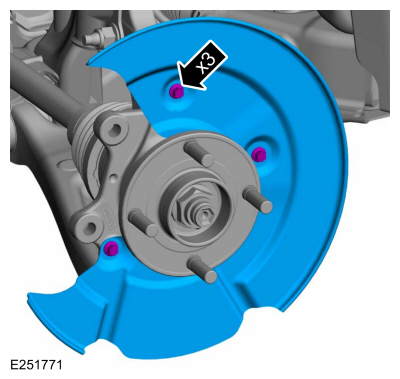| DTC |
Description |
Fault Trigger Condition |
| PCM P00FE:00 |
EVAP System Tank Vapor Line Restricted/Blocked: No Sub Type Information |
Sets when the PCM detects a restriction and the counter is incremented
and the counter reaches a calibrated number of completions.
The PCM monitors the EVAP
system for a restricted fuel vapor tube between the fuel tank pressure
sensor and the fuel tank. During the initial phase of the EVAP monitor,
the PCM closes the canister vent and a vacuum develops in the fuel
vapor tubes and lines and in the fuel tank. The PCM
monitors the fuel tank pressure sensor to determine the amount of
vacuum and how quickly the vacuum increases. The rate at which the
vacuum increases is compared to an expected value. If the vacuum
increases quicker than expected, a restricted fuel vapor tube is
suspected and an intrusive test is carried out in the final phase of the
EVAP monitor.
Check the fuel vapor tube for a restriction between the fuel tank
pressure sensor and the fuel tank.
|
| PCM P0442:00 |
EVAP System Leak Detected (small leak): No Sub Type Information |
Sets when the PCM detects a small fuel vapor leak by the EVAP running
loss monitor test.
Check for a missing fuel filler cap or the integrity of the cap (if
equipped).
Verify the
capless fuel tank filler pipe is sealed correctly. Install and remove
the supplemental fueling adapter five times in the capless fuel tank
filler pipe to clear debris on the seal. Refer to the Owner Literature
for the location of the supplemental fueling adapter in the vehicle.
Check for loose or damaged vapor hoses.
Visually inspect the EVAP canister inlet port, EVAP canister vent valve
filter, and canister vent hose assembly for contamination or debris.
|
| PCM P0443:00 |
EVAP System Purge Control Valve 'A' Circuit: No Sub Type Information |
Sets when the PCM detects the signal moves outside the minimum or
maximum limit for the commanded state.
To verify normal function, monitor the EVMV PID or EVAP canister
pressure PID and the signal voltage ( PCM control side). With the valve
closed, the EVMV indicates 0 mA (0% duty cycle for EVAP
canister pressure) and voltage approximately equal to battery voltage.
When the valve is commanded fully open, EVMV indicates 1,000 mA (100%
duty cycle for EVAP canister pressure) and a voltage drop of 3 volts
minimum is normal.
|
| PCM P0446:00 |
EVAP System Vent Control Circuit: No Sub Type Information |
Sets when the PCM detects the signal moves outside the minimum or
maximum allowable calibrated parameters for a specified EVAP canister
vent valve duty cycle by PCM command.
To verify normal function, monitor the EVAP canister vent valve signal
PID
EVAP canister vent and the signal voltage ( PCM control side). With the
valve open, EVAP
canister vent indicates 0% duty cycle and a voltage approximately
equal to battery voltage. When the valve is commanded fully closed, EVAP
canister vent indicates 100% duty cycle, and a minimum voltage drop of 4
volts is normal.
|
| PCM P0451:00 |
EVAP System Pressure Sensor/Switch 'A' Circuit Range/Performance: No Sub Type Information |
Sets when the PCM
detects a fuel tank pressure sensor range (offset) concern is
detected. The fuel tank pressure sensor output is offset by greater than
1.7 inches of water or less than -1.7 inches of water.
With the fuel tank pressure (FTP) sensor at atmospheric pressure, the FTP PID
normally indicates 0 inches of water. Remove the fuel filler cap or,
for vehicles with a capless fuel filler pipe, install the supplemental
refueling adaptor provided with the vehicle to open the capless fuel
tank filler pipe. After installing the supplemental refueling adaptor or
removing the fuel filler cap, wait one minute to allow the pressure in
the fuel tank to equalize with the ambient air pressure before accessing
the PID .
|
| PCM P0452:00 |
EVAP System Pressure Sensor/Switch 'A' Circuit Low: No Sub Type Information |
Sets when the PCM detects the fuel tank pressure sensor signal average
drops below a minimum allowable calibrated parameter.
A FTP voltage PID reading less than 0.22 volt in ignition ON, engine
OFF or ignition ON, engine running indicates a concern is present.
|
| PCM P0453:00 |
EVAP System Pressure Sensor/Switch 'A' Circuit High: No Sub Type Information |
Sets when the PCM detects the fuel tank pressure sensor signal average
jumps above a minimum allowable calibrated parameter.
A FTP voltage PID reading greater than 4.85 volt in ignition ON, engine
OFF or ignition ON, engine running indicates a concern is present.
|
| PCM P0454:00 |
EVAP System Pressure Sensor/Switch 'A' Circuit Intermittent: No Sub Type Information |
Sets when the PCM detects the fuel tank pressure changes greater than
14 inches of water in 0.10 seconds.
Monitor the FTP PID and note if it changes from greater than 15 inches
of water to less than minus (-) 15 inches of water often in 1 minute.
|
| PCM P0455:00 |
EVAP System Leak Detected - Large Leak: No Sub Type Information |
Sets when the PCM
detects no purge flow, which is attributed to fuel vapor restrictions,
a large fuel vapor leak, or multiple fuel vapor leaks are detected by
the EVAP running loss monitor test with the engine running, but not at
idle. The PCM monitors the complete EVAP control system for no purge
flow, the presence of a large fuel vapor leak, or multiple small fuel
vapor leaks.
Check for audible vacuum noise or significant fuel odor in the engine
compartment or near the EVAP
canister and fuel tank. Verify the capless fuel tank filler pipe is
sealed correctly. Install and remove the supplemental fueling adapter
five times in the capless fuel tank filler pipe to clear debris on the
seal. Refer to the Owner's's Literature for the location of the
supplemental fueling adapter in the vehicle.
|
| PCM P0456:00 |
EVAP System Leak Detected (very small leak): No Sub Type Information |
Sets when the PCM detects a very small fuel vapor leak by the engine
off natural vacuum leak check monitor. Refer to the EVAP Leak Check
Monitor, Engine Off Natural Vacuum Leak Check Monitor description for
additional information.
Check for a
missing fuel filler cap or the integrity of the cap (if equipped).
Verify the capless fuel tank filler pipe is sealed correctly (if
equipped). Install and remove the supplemental fueling adapter five
times in the capless fuel tank filler pipe to clear debris on the seal.
Refer to the Owner's's Literature for the location of the supplemental
fueling adapter in the vehicle. Check for loose or damaged vapor hoses.
Visually inspect the EVAP canister inlet port, EVAP canister vent valve
filter, and EVAP canister vent hose assembly for contamination or
debris.
|
| PCM P0457:00 |
EVAP System Leak Detected (fuel cap loose/off): No Sub Type Information |
Sets when the PCM
detects a gross leak while the refueling flag is set and a loose fuel
filler cap (if equipped) or an incorrectly sealed capless fuel tank
filler pipe (if equipped) is suspected. On most vehicles, a message on
the IPC displays to instruct the driver to check the fuel cap or capless fuel tank filler pipe (if equipped).
The PCM
continuously monitors the fuel level and retains the last updated
value prior to the ignition being placed in the OFF mode. After the
ignition is placed in the ON mode, a new fuel level is taken and
compared to the level recorded at ignition OFF. If the fuel level has
increased, a flag is set in the PCM indicating the vehicle was refueled.
Check for a
missing fuel filler cap or the integrity of the cap (if equipped).
Verify the capless fuel tank filler pipe is sealed correctly (if
equipped). Install and remove the supplemental fueling adapter five
times in the capless fuel tank filler pipe to clear debris on the seal.
Refer to the Owner's's Literature for the location of the supplemental
fueling adapter in the vehicle. If OK, clear the continuous memory
Diagnostic Trouble Codes (DTCs) and test the system for correct
operation.
|
| PCM P0460:00 |
Fuel Level Sensor 'A' Circuit: No Sub Type Information |
Sets when the PCM detects the FLI signal does not change or does not correspond with the calculated fuel usage. The PCM
calculates the amount of fuel used during operation. For vehicles with
a dual container (saddle type) fuel tank, either fuel level sensor may
set this DTC .
Check with the
customer for driving and fueling habits that would keep the fuel level
at approximately the same value. Monitor the FLI PIDs while attempting
to move the fuel level float by adding or removing fuel as necessary.
|
| PCM P0461:00 |
Fuel Level Sensor 'A' Circuit Range/Performance: No Sub Type Information |
Sets when the PCM
detects the fuel level imput (FLI) signal repeatedly moves in and out
of range, exceeding the minimum or maximum allowable calibrated
parameters for a specified fuel fill percentage in the fuel tank. For
vehicles with a dual container (saddle type) fuel tank, either fuel
level sensor may set this DTC .
Verify
aftermarket equipment does not generate radio frequency interference or
electromagnetic interference which may cause noisy fuel level input
(FLI) input signal.
|
| PCM P0462:00 |
Fuel Level Sensor 'A' Circuit Low: No Sub Type Information |
Sets when the PCM
detects the fuel level imput (FLI) signal is less than the minimum
allowable calibrated parameter for a specified fuel fill percentage in
the fuel tank.
Monitor the FLI PIDs with the ignition ON, engine running. A concern is present if the FLI percentage PID
is at 25% fill and the FLI voltage PIDs is less than 0.90 volt with a
non-matching fuel gauge or the FLI percentage PIDs is at 75% fill and
the FLI voltage PIDs is greater than 2.45 volts with a non-matching fuel
gauge.
|
| PCM P0463:00 |
Fuel Level Sensor 'A' Circuit High: No Sub Type Information |
Sets when the PCM
detects the fuel level imput (FLI) signal is greater than the maximum
allowable calibrated parameter for a specified fuel fill percentage in
the fuel tank.
Monitor the FLI PIDs with the ignition ON, engine running. A concern is present if the FLI percentage PID
is at 25% fill and the FLI voltage PIDs is less than 0.90 volt with a
non-matching fuel gauge or the FLI percentage PIDs is at 75% fill and
the FLI voltage PIDs is greater than 2.45 volts with a non-matching fuel
gauge.
|
| PCM P0496:00 |
EVAP System High Purge Flow: No Sub Type Information |
Sets when the PCM detects the EVAP running loss monitor detects
excessive fuel tank vacuum with the engine running, but not at idle.
Visually inspect the EVAP canister inlet port, EVAP canister vent valve
filter, and EVAP canister vent hose assembly for contamination or
debris.
Check the EVAP purge valve for vacuum leak.
|
| PCM P04F0:00 |
EVAP System High Load Purge Line 'A' Performance: No Sub Type Information |
Sets when the PCM
detects the fuel tank pressure exceeds a calibrated amount within a
specified amount of time during the test (single path check valve), or
when the fuel tank vacuum is less than a calibrated amount within a
specified amount of time or when the fuel tank pressure exceeds a
calibrated amount within a specified amount of time during the test
(dual path check valve). The EVAP check valve test is performed during
minimal boost conditions, once per drive cycle, when entry conditions
are met.
|
| PCM P144A:00 |
EVAP System Purge Vapor Line Restricted/Blocked: No Sub Type Information |
Sets when the PCM
detects the intrusive test confirms a restriction and the counter is
incremented and the counter reaches a calibrated number of completions.
The PCM monitors the EVAP
system for a restricted fuel vapor tube between the fuel tank pressure
sensor and the fuel tank. During the initial phase of the EVAP monitor,
the PCM closes the canister vent and a vacuum develops in the fuel
vapor tubes and lines and in the fuel tank. The PCM
monitors the fuel tank pressure sensor to determine the amount of
vacuum and how quickly the vacuum increases. The rate at which the
vacuum increases is compared to an expected value. If the vacuum
increases quicker than expected, a restricted fuel vapor tube is
suspected and an intrusive test is carried out in the final phase of the
EVAP monitor.
Check the fuel vapor tube for a restriction between the FTP sensor and
the fuel tank.
|
| PCM P144C:00 |
EVAP System Purge Flow Performance During Boost: No Sub Type Information |
Sets when the PCM
detects the fuel tank pressure exceeds a calibrated amount within a
specified amount of time during the test (single path check valve), or
when the fuel tank vacuum is less than a calibrated amount within a
specified amount of time or when the fuel tank pressure exceeds a
calibrated amount within a specified amount of time during the test
(dual path check valve). The EVAP check valve test is carried out during
minimal boost conditions, once per drive cycle, when entry conditions
are met.
|
| PCM P1450:00 |
Unable to Bleed Up Fuel Tank Vacuum: No Sub Type Information |
Sets when the PCM detects the EVAP running loss monitor detects
excessive fuel tank vacuum with the engine running, but not at idle.
Visually inspect the EVAP canister inlet port, EVAP canister vent valve
filter, and EVAP canister vent hose assembly for contamination or
debris.
Check EVAP purge valve for vacuum leak.
|
| PCM P2418:00 |
EVAP System Switching Valve 'A' Control Circuit/Open: No Sub Type Information |
Sets when the PCM detects the signal moves outside the minimum or
maximum limit for the commanded state of the EVAP vapor blocking valve.
|
| PCM P2450:00 |
EVAP System Switching Valve 'A' Perfomance/Stuck Open: No Sub Type Information |
Sets when the PCM detects the rate of vacuum loss is greater than a
calibrated threshold.
The PCM commands the EVAP
vapor blocking valve closed while vacuum is present in the fuel tank.
If the valve does not close, the vacuum in the tank is quickly lost.
Retrieve all continuous memory and on-demand self-test Diagnostic
Trouble Codes (DTCs) from the PCM . Diagnose any circuit related EVAP
vapor blocking valve Diagnostic Trouble Codes (DTCs) before diagnosing
this performance DTC .
Visually inspect the EVAP canister inlet port, EVAP canister vent valve
filter, fresh air hose and canister vent hose assembly for
restrictions, contamination or debris.
|
| PCM P260F:00 |
EVAP System Monitoring Processor Performance: No Sub Type Information |
Sets when the PCM detects a concern internal to the PCM
. The microprocessor that controls the engine off natural vacuum leak
check monitor is separate from the main processor within the PCM .
Verify the PCM is at the latest calibration level. Reprogram if necessary.
|
 PINPOINT TEST HX: EVAPORATIVE EMISSION (EVAP) SYSTEM AND MONITOR
PINPOINT TEST HX: EVAPORATIVE EMISSION (EVAP) SYSTEM AND MONITOR
 Introduction
Introduction
 General Procedures - Evaporative Emission System Leak Test
General Procedures - Evaporative Emission System Leak Test
 PINPOINT TEST HX: EVAPORATIVE EMISSION (EVAP) SYSTEM AND MONITOR
PINPOINT TEST HX: EVAPORATIVE EMISSION (EVAP) SYSTEM AND MONITOR

 Introduction
Introduction
 WARNING:
Before working on or disconnecting any of the fuel
tubes or fuel system components, relieve the fuel system pressure to
prevent accidental spraying of fuel. Fuel in the fuel system remains
under high pressure, even when the engine is not running. Failure to
follow this instruction may result in serious personal injury.
WARNING:
Before working on or disconnecting any of the fuel
tubes or fuel system components, relieve the fuel system pressure to
prevent accidental spraying of fuel. Fuel in the fuel system remains
under high pressure, even when the engine is not running. Failure to
follow this instruction may result in serious personal injury.

